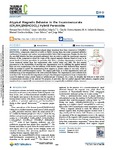Atypical Magnetic Behavior in the Incommensurate (CH3NH3)[Ni(HCOO)3] Hybrid Perovskite

View/
Use this link to cite
http://hdl.handle.net/2183/32982Collections
- Investigación (FCIE) [1228]
Metadata
Show full item recordTitle
Atypical Magnetic Behavior in the Incommensurate (CH3NH3)[Ni(HCOO)3] Hybrid PerovskiteAuthor(s)
Date
2023-02-02Citation
Pato-Doldán, B., Cañadillas-Delgado, L., Gómez-Aguirre, L. C., Señarís-Rodríguez, M. A., Sánchez-Andújar, M., Fabelo, O., and Mira, J. (2023). Atypical Magnetic Behavior in the Incommensurate (CH3NH3)[Ni(HCOO)3] Hybrid Perovskite. The Journal of Physical Chemistry C 127 (6), 3330-3338. DOI: 10.1021/acs.jpcc.2c08364
Abstract
[Abstract] A plethora of temperature-induced phase transitions have been observed in (CH3NH3)[M(HCOO)3] compounds, where M is Co(II) or Ni(II). Among them, the nickel compound exhibits a combination of magnetic and nuclear incommensurability below Néel temperature. Despite the fact that the zero-field behavior has been previously addressed, here we study in depth the macroscopic magnetic behavior of this compound to unveil the origin of the atypical magnetic response found in it and in its parent family of formate perovskites. In particular, they show a puzzling magnetization reversal in the curves measured starting from low temperatures, after cooling under zero field. The first atypical phenomenon is the impossibility of reaching zero magnetization, even by nullifying the applied external field and even compensating it for the influence of the Earth’s magnetic field. Relatively large magnetic fields are needed to switch the magnetization from negative to positive values or vice versa, which is compatible with a soft ferromagnetic system. The atypical path found in its first magnetization curve and hysteresis loop at low temperatures is the most noticeable feature. The magnetization curve switches from more than 1200 Oe from the first magnetization loop to the subsequent magnetization loops. A feature that cannot be explained using a model based on unbalanced pair of domains. As a result, we decipher this behavior in light of the incommensurate structure of this material. We propose, in particular, that the applied magnetic field induces a magnetic phase transition from a magnetically incommensurate structure to a magnetically modulated collinear structure.
Keywords
Chemical structure
Crystal structure
Hysteresis
Magnetic properties
Phase transitions
Crystal structure
Hysteresis
Magnetic properties
Phase transitions
Editor version
Rights
Atribución 4.0 Internacional
ISSN
1932-7455






